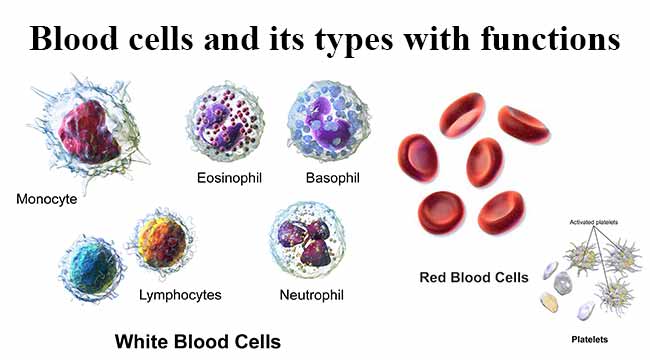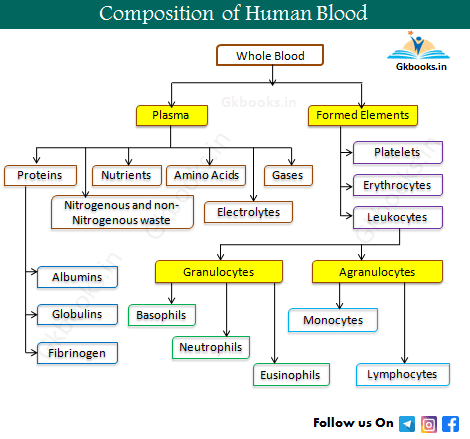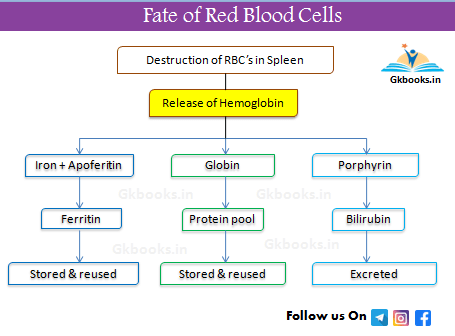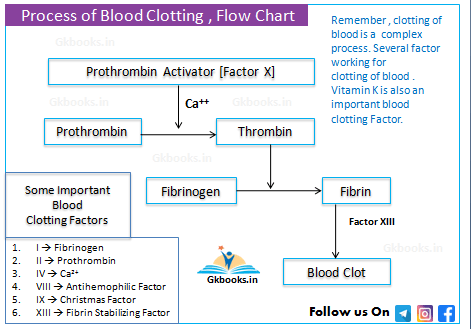General Science is crucial for various competitive exams, such as SSC, WBCS, NTPC, UPSC, RAIL, Banking, and other state PSCs. Among the many subjects covered in General Science, the composition and function of human blood are especially important. To provide a comprehensive overview of this topic, we have included a brief note on the blood composition in this post. The next post will cover blood groups and circulation methods. For further information, please download the Composition of Blood PDF from the link provided at the end of this article.
Introduction
▪ Providing nutrients, oxygen, and other essential substances to all living cells in an animal body and the continuous removal of waste or harmful substances is crucial to maintaining healthy and robust tissues.
▪ Various groups of animals have evolved different mechanisms to achieve efficient transport of these substances. Simple organisms, such as sponges and coelenterates, use the water canal system and gastrovascular cavity to exchange these substances.
▪ More complex organisms, including humans, have developed a highly specialized circulatory system that uses blood as the primary body fluid for the transportation of these vital materials.
▪ Blood is composed of plasma and cells, such as red and white blood cells and platelets, that play specific roles in transporting nutrients and oxygen, removing waste products, and defending against foreign substances.
▪ Additionally, the lymphatic system, which comprises lymph nodes, lymph vessels, and lymph fluid, assists in transporting certain substances and plays a vital role in the body’s immune defence.
▪ The efficient transport of substances is essential for the proper functioning of all tissues and organs in an animal body, from the smallest cells to the most complex organ systems.
• Substance transported by blood
* Nutrients – Glucose, Fatty acids, Vitamins
* Waste products of metabolism
* Respiratory gasses – O2 and CO2.
* Hormones
What is Blood?
▪ Blood is a special connective tissue consisting of plasma and formed elements (RBC, WBC, platelets).
Physical Properties of Blood
▪ Fresh blood has a unique smell.
▪ Venous blood is dark red or bluish because of the high concentration of carbon dioxide in the blood.
▪ Arterial blood is bright red due to the high oxygen content in the arterial blood.
▪ Blood tastes salty due to the presence of NaCl (0.97%).
▪ Blood is alkaline, with an average pH of 7.4.
▪ The Specific gravity of blood is 1.005-1.065
▪ The relative viscosity of blood is about 4-6.
Blood Volume in Man
▪ The amount of blood in the body of a healthy adult male (5 feet in height and 70 kg weight) is about 5000 ml or 5 litres, while in a female it is 4.5 litres.
Chemical Composition of Blood
▪ Blood contains 55% plasma, 1% platelets, white blood cells, and 44% red blood cells.
▪ The ratio of plasma and blood cells (55: 45) is called the Haemocrite value of blood.
Plasma
▪ Plasma is a straw-coloured (Pale Yellow), viscous fluid of the blood, in which the red blood cells, white blood cells, and platelets are suspended.
Composition of Plasma
▪ It constitutes more than half of the blood’s volume (55%) and consists mostly of water (90-92%) that contains dissolved salts (electrolytes) and proteins (6-8%).
Nitrogenous waste
▪ Plasma contains some Nitrogenous wastes.
▪ Example ☞ Urea and Creatinine, Uric Acid
Non-nitrogenous Waste
▪ Example ☞ Glucose, amino acids, lipids
Amino Acids
▪ Example ☞ : Alanine and Glutamine
Electrolytes (0.9%)
▪ Plasma also contains small amounts of minerals.
▪ Example ☞ Na+, Ca++, Mg++, HCO3–, Cl– etc.
Gases (1-2%)
▪ Example ☞ O2 and CO2
Nutrients
▪ Plasma contains nutrients that nourish tissues.
▪ Example ☞ : Amino acids, the building blocks of proteins and glucose.
Proteins (6–8%)
▪ Example ☞ Fibrinogen, Globulins, and Albumins
▪ Fibrinogens are needed for clotting or coagulation of blood.
▪ Globulins are primarily involved in the defence mechanisms of the body.
▪ The albumins help in maintaining osmotic balance, also known as Oncotic pressure (standard value – 25 mmHg)
▪ Factors for coagulation or clotting of blood are also present in the plasma in an inactive form
▪ Plasma without clotting factors is called serum.
• Fibinogens are essential for coagulation of blood.
• Fibinogen is the heaviest protein in blood plasma.
• Most abundant (80%) immunoglobulin in serum – IgG
• Albumin is a protein made by the liver (12 gm/Day)
• Albumin is the most abundant protein (60%) in blood plasma.
• Serum albumin levels are tested to detect any liver disease.
Plasma Proteins
| Albumin | Globulins | Fibrinogen | Prothrombin | |
|---|---|---|---|---|
| Produced by | Liver | Liver, Lymphoid tissue | Liver | Liver |
| Percentage | 3.5-5.0 % | 2.5-3.5 % | 0.3 % | 0.01% |
| Function | Maintaining osmotic pressure | Defense function | Blood clotting and Viscosity | Blood Clotting |
Formed Elements
▪ Erythrocytes, leukocytes, and platelets are collectively called formed elements.
▪ They constitute nearly 45 per cent of the blood
Erythrocytes
▪ Erythrocytes are also known as red blood cells (RBC).
▪ They are the most abundant of all the cells in the blood.
▪ A healthy adult man has, on average, 5 million to 5.5 million RBCs mm3 of blood.
▪ Red bone marrow in the adults produced the RBCs.
▪ Red blood cells do not have a nucleus.
▪ The RBCs are biconcave in shape.
▪ They have a red colour, due to the presence of haemoglobin.
▪ Hemoglobin is an iron-containing complex protein.
▪ A healthy individual has 12-16 gms of haemoglobin in every 100 ml of blood.
▪ These molecules play a considerable role in the transport of respiratory gases.

▪ The formation or production of red blood cells is known as Erythropoiesis.
▪ The average life span is 120 days, after which they are destroyed in the spleen, the graveyard of RBCs.
• The bone marrow produces 3 million red blood cells every second.
• Life span of RBC – 120 days
• RBC’s take 20 seconds to circulate the body one time.
• Each RBC contains 1 billion molecules of Oxygen.
• Each RBC contains 280 million Hemoglobin molecule.
• In a 70 Kg man there is 4gm of iron.
Leukocytes
▪ Leukocytes are also known as white blood cells (WBC) as they are colourless due to the lack of haemoglobin.
▪ They are nucleated and are relatively lesser in number which average 6000-8000 mm3 of blood.
▪ Leukocytes are generally short-lived. Lifespan 13–20 days.
▪ WBCs are classified into major categories – granulocytes and agranulocytes.
▪ Granulocytes include neutrophils, eosinophils, and basophils.
▪ While lymphocytes and monocytes are the agranulocytes.
▪ Neutrophils are the most abundant cells (60-65 %) of the total WBCs and basophils are the least (0.5-1 %) among them.
▪ Neutrophils and monocytes (6-8 %) are phagocytic cells, which destroy foreign organisms entering the body.
▪ Basophil secrete histamine, serotonin, heparin, etc., and is involved in inflammatory reactions.
▪ Eosinophils (2-3 %) resist infections and are associated with allergic reactions.
▪ Lymphocytes (20-25 %) are of two major types – B and T forms.
▪ Both B and T lymphocytes are responsible for the immune responses of the body.
Platelets
▪ Platelets also called thrombocytes.
▪ Platelets are cell fragments produced from megakaryocytes (special cells in the bone marrow).
▪ Blood normally contains 1,500,00-3,500,00 platelets mm3.
▪ Platelets can release a variety of substances most of which are involved in the coagulation or clotting of blood.
▪ A reduction in their number can lead to clotting disorders, leading to excessive blood loss from the body.
▪ Lifespan 3 days.
Formed Elements of Blood (45%)
| Cell Type | Number Per mm3 | Function |
|---|---|---|
| Erythrocytes (RBCs) | 5-6 million | Transport of Oxygen and Carbon dioxide |
| Leukocytes (WBCs) | 5k-10k | Defense and immunity |
| Platelets | 2.5-4 lakh | Blood Clotting |
Blood Clotting
▪ Blood Clotting is a mechanism to prevent excessive loss of blood from the body.
▪ A dark reddish brown serum formed at the site of a cut or an injury over a period of time.
▪ It is a clot or coagulum constituted mainly of a network of threads called fibrils in which dead and damaged formed elements such as Erythrocytes, leukocytes, and platelets of blood are trapped.
▪ Fibrins are formed by the conversion of inactive fibrinogens in the plasma by the enzyme thrombin.
▪ Thrombins, in turn, are formed from the other inactive substance present in the plasma called prothrombin.
▪ An enzyme complex, thrombokinase, is needed for the above reaction.
▪ This enzyme complex is formed by a series of linked enzymic reactions (cascade process) involving several factors present in the plasma in an inactive state.
▪ An injury triggers the platelets in the blood to release certain factors that activate the coagulation mechanism.
▪ Certain factors released by the tissues at the site of injury also can initiate coagulation.
▪ Calcium ions play a vital role in clotting.
Lymph
▪ Our heart pumps blood with some pressure. As a result of this pressure, when the blood passes through the capillaries into the tissue, some water, and many small water-soluble substances move into the space between the tissue cells, large proteins, and most of the components formed in the blood vessels.
▪ This fluid released into the intercellular space is called the interstitial or tissue fluid.
▪ Interstitial or tissue fluid has the same mineral distribution as plasma.
▪ Exchange of nutrients, gases, etc., between the blood and the cells always occurs through this fluid.
▪ An elaborate network of vessels called the lymphatic system collects this fluid and drains it back to the major veins.
▪ The fluid present in the lymphatic system is called lymph.
▪ Lymph is a colourless fluid containing specialized lymphocytes that are responsible for the immune responses of the body.
▪ Lymph is also an important carrier of nutrients, hormones, etc. Fats are absorbed through lymph in the lacteals present in the intestinal villi.
More important info about the Colour of Blood
•The colour of blood varies among different organisms and depends on the type of respiratory pigments they use to transport oxygen. Human blood appears red due to haemoglobin, an iron-rich protein found in red blood cells. However, other species have the blood of different colours. For instance, spiders, squid, octopuses, and arthropods have blue blood, while certain worms and leeches have green blood. Insects like butterflies and beetles have colourless or pale-yellowish blood. Interestingly, some marine animals have yellow blood. The diversity in blood colours across various organisms is a fascinating aspect of nature’s evolution and adaptation.
Various Colours of Blood
| Colour | Respiratory Pigments | Metal Presents | Species /Animals |
|---|---|---|---|
| Yellow | Haemovanabine | Vanadium | Beetles, Sea squirts, Sea cucumber. |
| Green | Chlorocruorin | Iron | Leeches and marine worms |
| Purple | Haemerythrin | Iron | Peanut worms (Sipuncula), Penis worms (Priapulida), Brachiopods |
| Blue | Haemocyanin | Copper | Horseshoe crabs, Crustaceans |
| Red | Hemoglobin | Iron | red blood cells of all vertebrate animals |
Function of Blood
▪ Let us briefly discuss the various functions of blood after having discussed its composition thus far.
General Function of Blood
• Transport of Nutrients
• Transport of Respiratory Gases
• Drainage of waste products.
• Act as a medium of transport.
• Maintenance of water balance
• Maintenance of Acid-base equilibrium
• Maintenance of ion balance
• Regulation of body temperature
• Prevents Haemorrhage
• Defensive action
The function of Blood Corpuscles
The function of Red Blood cells
• Transport of Respiratory gases. E.g Oxygen and Carbon dioxide
• Acid-base balance
• Ion balance
• Viscosity of blood
• Sources of various pigments. E.g bilirubin, Biliverdin [see the image ‘fate of RBC’]
The function of White Blood cells
• Destruct foreign particles using the phogocytosis method.
• Formation of Antibody
• Formation of Fibroblasts
• Manufacture of Trephones
• Secretion of Heparin
• Resistance to Allergy
• Destruction of Tumour cells
Function of Platelets
• Clotting of Blood
• Repair of the capillary endothelium
• Hasten clot retraction
Function of Plasma
• Transport of Nutrients.
• Drainage of waste products
• Maintenance of acid-base equilibrium
• Regulation of body temperature
• Maintenance of water balance
• Regulation of Blood Pressure
• Transport of Hormones
• Protect Haemorrhage
Composition of Blood PDF Download
Composition of Blood PDF Details
| Data | Details |
|---|---|
| File Name | Composition of Blood PDF Download |
| File Type | |
| File Size | 900KB |
| PDF Quality | Good |
| No. of Pages | 11 |
| Category | General Science- Biology PDF |
| Publication | GKBOOKS |
Composition of Blood PDF Preview
Composition of Blood PDF Download 👇
Primary Source – NCERT [Body Fluids and Circulation]






